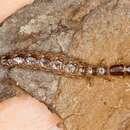en
names in breadcrumbs


Raphidioptera (snakeflies) are regarded as one of the most primitive lineages of holometabolous insects, their fossil record dating back to the Early Jurassic (Grimaldi and Engel 2005). There is consensus that Raphidioptera forms a distinct clade together with Megaloptera and Neuroptera, the superorder Neuropterida. However, there is controversy whether Raphidioptera is sister to Megaloptera or to [Megaloptera + Neuroptera] (see Haring et al. 2011).
Nowadays, the active, predatory larvae of snakeflies are long-lived, with a high number of instars and distinctive hibernating periods, living under the bark of trees and shrubs or in soil detritus; moreover, their pupation needs a period of cold to break diapause, and the pupae are exarate and active, a plesiotypic condition within Holometabola (Aspöck 2002). Adults are arboreal and also predatory, but short-lived (ibid.), exhibiting a prognathous head, a long pronotum, and a long ovipositor in females, features that give them a snake-like appeareance.
The extant diversity of the order is relictual, as the Mesozoic diversity of Raphidioptera, as suggested by morphological disparity more-so-than total numbers, was greater than that observed today (e.g., Martynov 1925; Martynova 1961; Ponomarenko 1988, 1993; Oswald 1990; Ren 1997; Engel 2002; Engel et al. 2006; Perrichot and Engel 2007; Jepson and Jarzembowski 2008; Jepson et al. 2009, 2011). Moreover, while the group was once distributed throughout the world and in diverse habitats, today their range is contracted into the cold temperate regions of the Northern Hemisphere.
The fossil record of Raphidioptera is comprised principally of compressions ranging from the Early Jurassic through the Miocene (Engel 2002). Snakefly inclusions in amber are far more uncommon (e.g., Carpenter 1956; Engel 1995; Aspöck and Aspöck 2004), particularly those in Cretaceous resins (Grimaldi 2000; Engel 2002; Perrichot and Engel 2007; Engel and Grimaldi 2008; Pérez-de la Fuente et al. 2010; Bechly and Wolf-Schwenninger 2011).
Snakeflies are found throughout the Holarctic Region and are most concentrated in the Palaearctic Region.In North America, the two genera that reside there are usually found in the western United States, especially in the Rocky Mountains and the southwestern deserts.Two species are found in the pine forests of Oaxaca, Mexico. Order Raphidioptera consists of two families: Raphiididae and Inocelliidae. There are currently about 210 existing species of Snakeflies.